How do the best professional services firms keep growing while others fall behind? The answer is simple: The top organizations invest in resource management.
Market leaders know how to maximize their time, talent, and tools. When these pieces come together, they help keep budgets in check, maintain profitability, and improve service delivery for internal or external clients.
Opportunities slip away without the right talent in place. Again, the difference is that top organizations make resource management a priority to drive change. Top companies are 43% more likely to refine their resource processes and 50% more likely to plan resource needs upfront.
This blog explores the 15 reasons why leading professional services firms are making resource management their focus—and why it’s paying off.
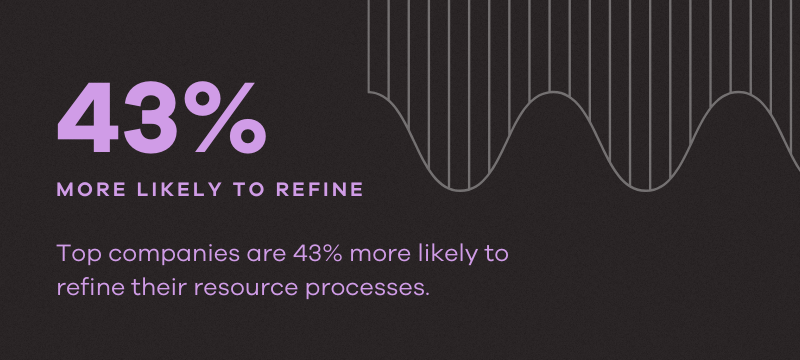
What is Resource Management?
Resource management involves capacity planning, scheduling, and assigning specific resources, like people, budget, and technology, to projects. It ensures you have what you need and uses it to deliver the results your stakeholders seek. When resource management is done right, it drives operational costs down and profits up for a more substantial return on investment.
What Does Resource Management Involve?
- Devising Your Strategy: To start, assess whether the project is doable. Break down goals, estimate costs, and match resources. Focus on the work’s impact on your business, and use capacity planning to guide your approach. The goal is to understand your capacity and whether the required resources can be delivered.
- Building the Right Team: Assign resources based on skills, availability, and certifications to ensure the right expertise for each task.
- Tracking Progress: Monitor your projects in real time to spot and address issues early, keeping everything on track.
- Managing Budgets: Stay on top of billable and non-billable hours, costs, and revenue impact by tracking entries and expenses against project goals.
- Using the Right Tool: A solution like Upland PSA brings everything together. It helps forecast demand, track availability, assign skilled resources, monitor workloads, and manage budgets. This keeps your process smooth and decisions clear. Upland PSA simplifies every resource management process.
Why is Resource Management Important?
Every successful project plan starts with smart resource management. It helps businesses reach their growth potential and maintain strong relationships with clients. Here’s why resource management matters:
- Resource management reduces waste and helps prevent overcommitment. It also ensures that resources are used wisely so teams stay focused.
- It drives profits. In 2024, the professional services sector saw 7.56% revenue growth and a 12.45% net profit margin, outperforming the industry average. Resource management has played a significant role in these results.
- It closes skills gaps and makes resource planning more accurate. However, only some have tools that work well for them.
- Resource management helps prevent burnout and keeps teams happy and productive. Overcommitted teams face delays, while successful projects stick to a balanced workload.
- Resource management also solves capacity planning problems linked to poor forecasting and resource planning. Efficient resource management helps everything fall into place.
Remember that resource utilization and management isn’t only about what you have—it’s about how you use it.
With Upland PSA’s resource management capabilities, you can make the most of what your team has and better understand what you need. This helps keep clients happy and gain a competitive edge while keeping your service delivery operations efficient and profitable.
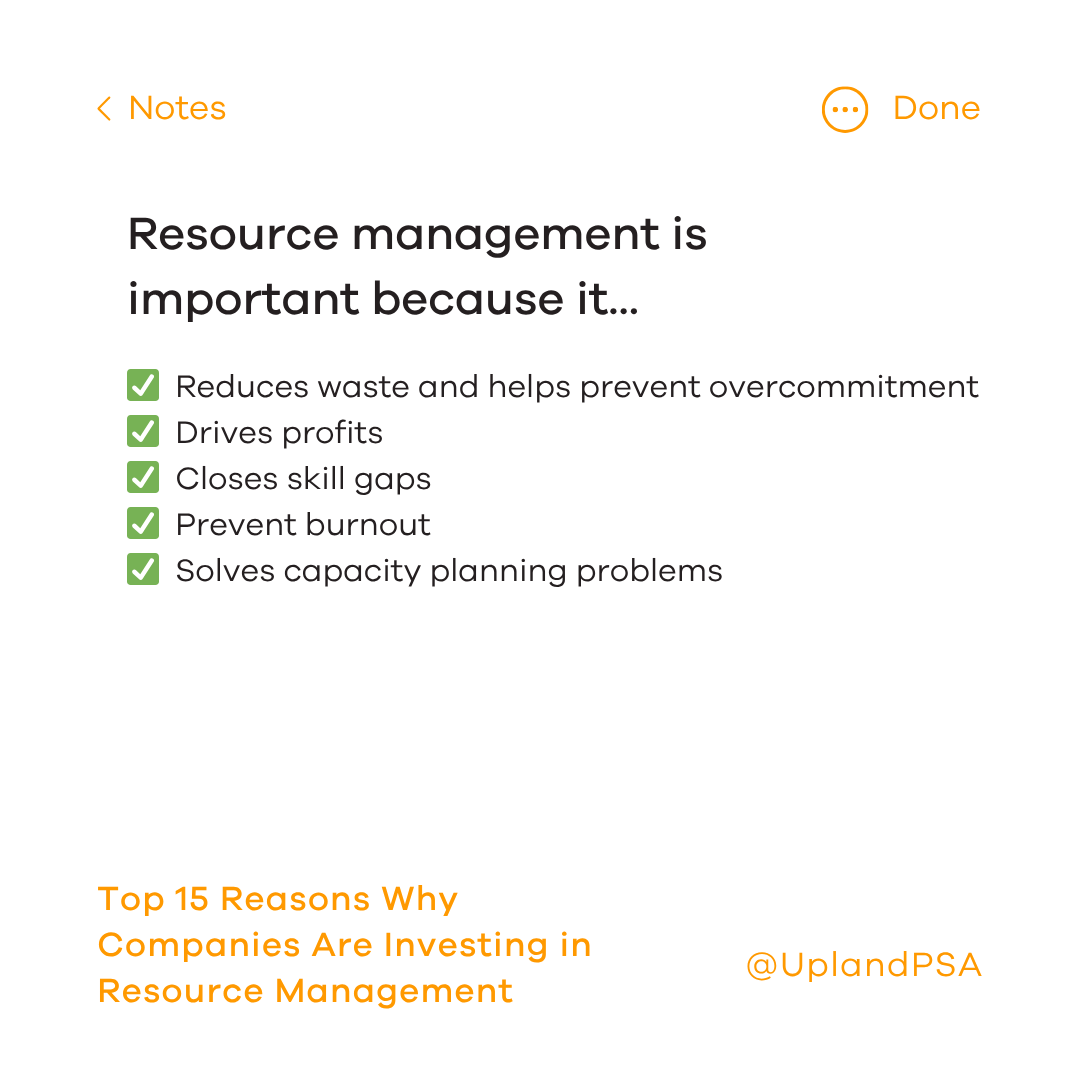
15 Reasons Why Companies Are Prioritizing Resource Management in 2025
Every business tries to do more with less. That’s nothing new. However, it’s getting harder to balance priorities on where to focus. The evolution of technology and AI, widespread talent shortages, rising costs, and shifting employee expectations are pushing companies to rethink how they manage resources. Here’s why resource management matters for professional services in 2025.
1. Flexibility is the New Standard
Employees want flexibility. The last few years have fundamentally changed how we work, and employee expectations have shifted.
An American Opportunity Survey found that 58% of Americans have the option to work remotely at least one day a week, and 35% can work entirely remotely. These changes in how we work call for better resource management.

2. Helps to Plan Smarter, Grow Faster
Uncertainty is a challenge in professional services. Organizations often struggle with unpredictable workloads and fluctuating project demands. Workloads shift, project demands change, and priorities can flip overnight.
Company-level resource management helps mitigate this. It offers a capacity planning process and provides a clear view of workforce needs, service delivery, supply chain, and project pipelines. This visibility allows teams to manage multiple projects simultaneously across their collective resources.
According to McKinsey, resource allocation is key to driving growth, and 83% of executives agree. More intelligent resource capacity planning helps teams adapt to changes while staying focused on their goals. It helps companies improve predictability while driving profitability.
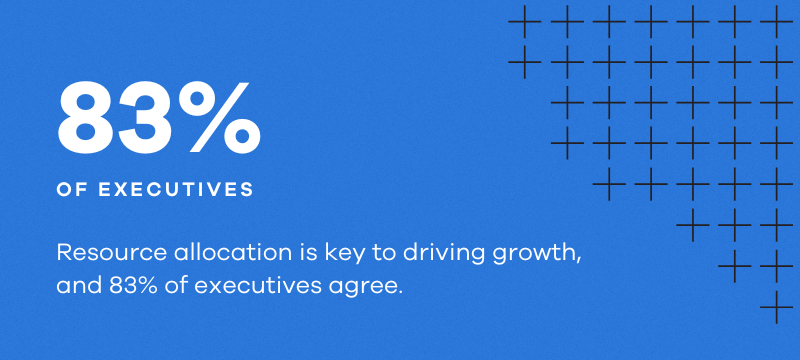
3. Cuts Costs Without Cutting Corners
Controlling costs has never been more critical, with inflation and tighter budgets putting pressure on professional services. KPMG reports that 85% of organizations now analyze costs and profitability from multiple angles.
One key benefit of resource management is the ability to budget for changing demand. This allows businesses to adjust production capacity, reduce waste, and create more accurate budgets.
With dedicated resource plans, companies can weather economic challenges, prevent scheduling conflicts, and maintain profitability even during tough times.
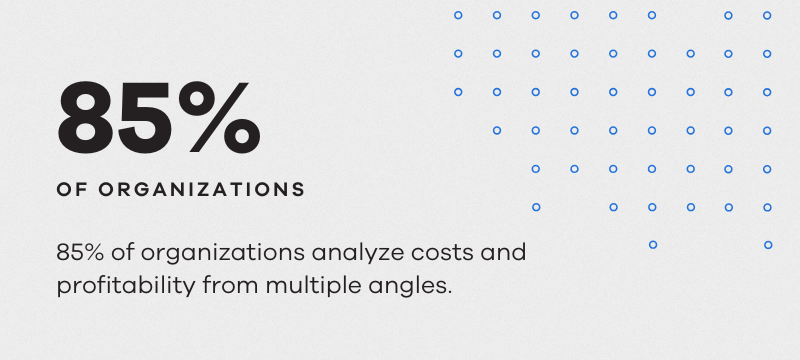
4. Maximize Talent Use
Professional services face a tight labor market. The Bureau of Labour Statistics found that in October 2024, job openings hit 1,870, but hires lagged at 1,075, and separations stayed high at 1,108. With gross job gains barely outpacing losses, growing teams is challenging.
Resource management helps firms maximize the use of their staff talent. It balances workloads to prevent burnout and improve efficiency. Matching tasks to employee strengths boosts productivity without extra hires. It also highlights skill gaps so firms can upskill their teams instead of replacing them. This approach keeps teams productive, even with limited resources.
5. Breaks Down Silos
Poor data costs businesses a fortune yearly, and it’s not just about the money. For professional services, it often means siloed information and limited visibility. Decisions take longer, and unnecessary complexity slows everything down.
Centralized company resource management solves this. It gives a clear view of skills, availability, and workloads. Teams get the information they need to make better calls. Harvard Business Review points out that 75% of cross-functional teams struggle to function effectively. Siloed data and unclear goals are significant reasons why.

With centralized data, teams break down silos and align their efforts. Everyone shares the same goals and works together more effectively. Collaboration improves, decisions get faster, and results speak for themselves.
6. Data-Driven Hiring Is Made Easy
Hiring the right people is a challenge for professional services firms. Tight deadlines and client demands leave no room for mistakes. However, smart hiring is a crucial investment of resources to support future profit. That’s why many firms offer resource management features.
These tools, like Upland PSA, provide data on workforce gaps and skills needs. They show whether to hire full-time staff, bring in contractors, or upskill the team.
Hence, more thoughtful decisions can save time and money. Resource management also prevents common issues like overstaffing or hiring the wrong skills.
Measuring the return on investment in human resources helps firms get the most from their teams. Tracking ROI in human resources highlights the value of training and development. It makes sure workforce investments pay off. After all, a strong team makes all the difference.
7. Helps Adapt to Economic Pressures
Knowing where to invest resources in professional services can be challenging when times are tough. That’s why economic uncertainty calls for careful capacity planning. During the COVID-19 pandemic, professional services emerged as one of the strongest industries.
Resource management played a key role. Grant Thornton’s index highlighted that firms in this sector created detailed plans covering financial resources, leadership, and people management.
Firms directed their resources to areas with the most significant impact, ensuring that time and budgets were utilized effectively. This approach focuses on work that drives real client value and maximizes tight budgets and limited time.
Resource management helps companies focus on value-adding projects. It focuses on making the most of limited resources during global uncertainty.
8. Gets Projects Over the Finish Line
Project-based work is gaining traction, driven by competitive, regulatory, and social pressures. Projects comprise about 30% of economic activity in countries like Germany, Iceland, and Norway. The U.S. is experiencing the same. Project-based work is growing, with businesses shifting to a skills-based model.
As this trend grows, having the right people in the right roles is more important than ever. Intelligent resource management does that. It keeps everything in motion and ensures every new project has the best chance of success.
After all, with 70% of projects failing to meet expectations, sound resource management can stack the odds in your favor.

9. Keep their Best People Happy
Holding onto talent is difficult in professional services. Recent data from the U.S. The Bureau of Labor Statistics reveals an industry-wide increase in job openings and steady separations at 1.1 million, with a slight uptick in voluntary quits. So, while the job market is busy, turnover remains constant, and more workers are pursuing new opportunities.
There are ways around this. Highly engaged workers are more likely to stay. Gallup reports that in high-turnover businesses, engaged units experience 18% less. Good resource management helps keep teams engaged and motivated.
When employees feel their skills are valued and workloads are balanced, they’re more likely to stand the test of time. Clear growth opportunities and a supportive work environment also play a notable role. Keeping your best people happy means they’re less likely to look elsewhere.
10. Supports Remote and Hybrid Work Models
Professional services firms are considering resource management to support remote and hybrid work models. With 8 in 10 employees working remotely or in hybrid settings, Gallup highlights the increasing demand for flexible hours and manageable tasks.
Remote work has clear benefits. Pew Research found that 71% of remote workers say it improves their work-life balance, but 12% still struggle. Firms can take on these challenges with better resource management. Remember, minor adjustments can go a long way. They help maximize the benefits of flexible work and keep teams productive.

The right tools, like Upland PSA, help allocate tasks, track time and keep things running smoothly—no matter how much excess capacity you have or where your team is. These strategies help firms maintain momentum while giving employees the flexibility to meet client demands.
11. Allows for Better Decision-Making
Better decisions come from better data, especially with firms’ intense competition. The market is fast-moving, and firms need access to accurate, real-time insights to stay ahead. Without it, they risk falling behind.
That’s why more firms are turning to tools with resource management capabilities, like Upland PSA, to get the needed insights.
Upland PSA helps firms allocate resources based on skills and availability. It’s helped countless firms place expertise where it matters most.
They can monitor workforce capacity, track progress, and predict future needs. There’s no need to rely on guesswork, and resource management enables quick adjustment to changes.
12. Matches Skills to Strategy
Professional services firms are realizing the power of aligning skills with strategy. They understand that traditional job structures can restrict flexibility and slow growth. The established way of organizing work doesn’t always allow you to get the right minds behind the projects. The solution is to focus on the skills that align with the direction you plan to go in.
Unilever is an excellent example of this. Its approach views roles as a mix of skills rather than job titles. This helps them pair people to projects that match their strengths, encouraging innovation and agility.
Resource management helps you identify the skill sets and gaps. It also allows you to keep tabs on current capacity and development, which keeps the workforce ready for whatever’s ahead. The World Economic Forum says 44% of workers’ skills will be disrupted in the next five years.
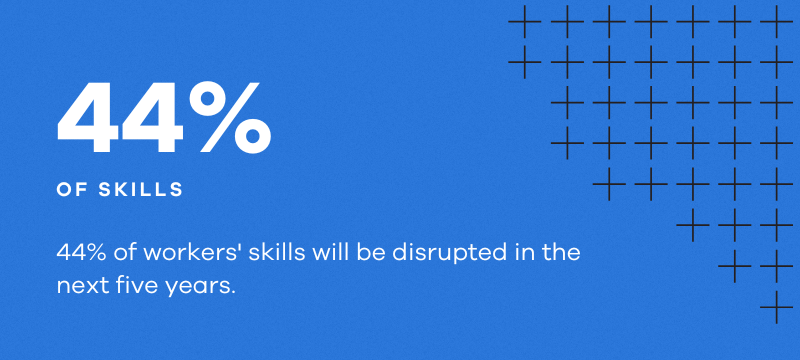
Resource management also leads to stronger team engagement by tapping into strengths. Companies that focus on skills, not just titles, create a more flexible, inclusive, and efficient work environment.
13. Helps Stay One Step Ahead of Risks
Risks are part of every professional services project. Delays, budget overruns, and changing client needs can all throw things off course. Resource management helps teams identify these issues early and take action before they become more significant problems later.
Resource management identifies bottlenecks and prevents inefficiencies. As Aon points out, 72% of professional services firms use resource management to mitigate risks.
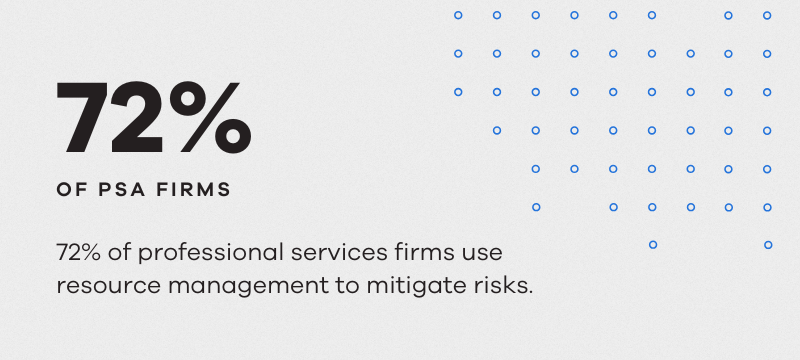
They’re able to anticipate risks like evolving regulations or market shifts. While these risks are always present, tools like Upland PSA are helping firms lower their exposure to them.
14. Cuts Back on Admin
There is a range of tasks in professional services that waste time and resources. PwC estimates that 40% of administrative time goes to waste. This means less time for what matters in professional services.
Tools like Upland PSA help reduce this inefficiency. They automate tasks like scheduling, reporting, and forecasting. By handling these activities automatically, businesses quickly save time and reduce errors.
It frees up teams to focus on strategy and high-value work. Firms can improve productivity and see results with less admin on their plate.
15. Focuses on Sustainable Growth
Investing in effective resource management isn’t just about short-term gains. It’s a strategy for long-term success. Companies set themselves up for sustainable growth by optimizing available resources and aligning skills with their goals. Resource management makes sure firms stay quick on their feet as their needs shift.
Top-performing firms and departments are 59% more likely to have a standardized process for managing new requests and to practise other project management standards. They also allocate resources earlier, which helps lock in more accurate pricing and fewer surprise costs.
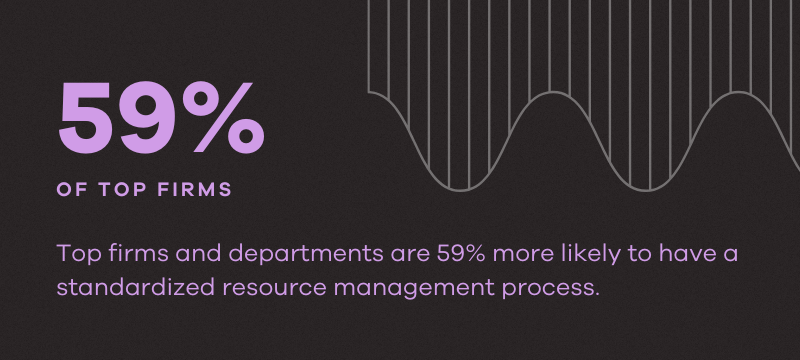
Get a Handle on Resource Management with Upland PSA
In short, sound resource management sets professional services apart. Without it, costs can quickly spiral out of control. The Project Management Institute found that 21% of projects fail because resources are too limited or overtaxed. The impact of poor resource management goes beyond individual projects. It ripples through team performance and the organization as a whole.
When you don’t know where to invest resources, teams face heavier workloads, longer hours, and more stress. This leads to setbacks and, in some cases, financial troubles.
Upland PSA makes it easier for firms to manage resources and avoid these common setbacks. Real-time insights help firms simplify their operations and make smarter decisions. Staying ahead of resource challenges helps them keep moving forward.
Want to improve your resource management? Start using Upland PSA and take control of your projects, costs, and teams. Explore Upland PSA today.
